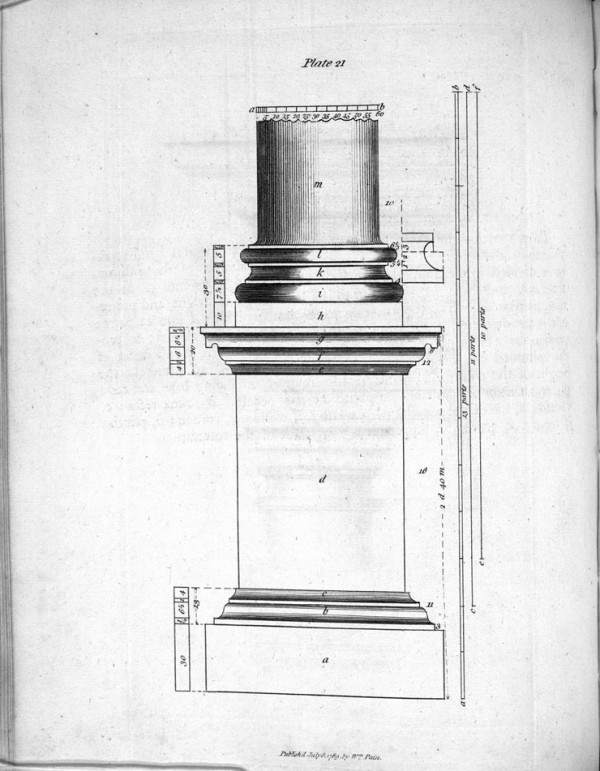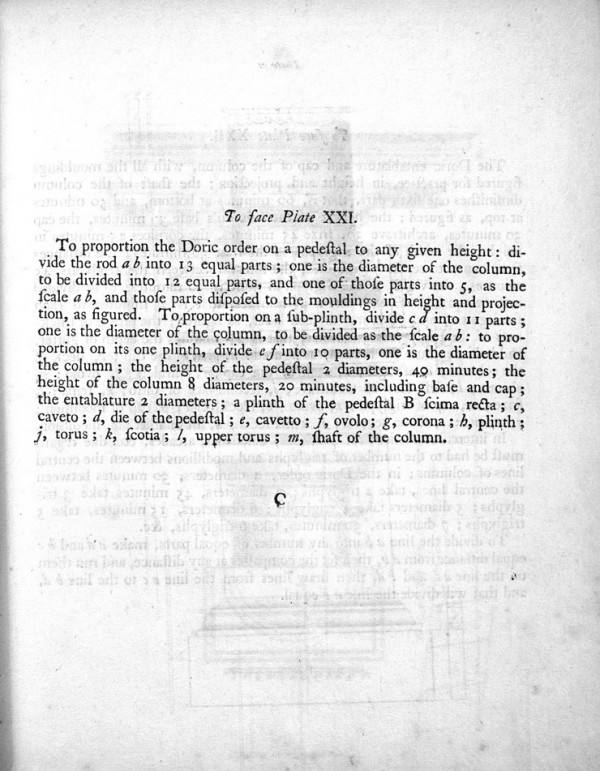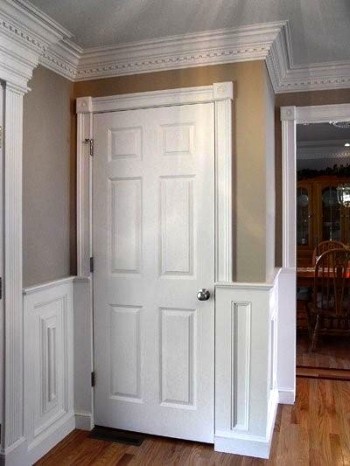Dining Room Chair Rail Ideas
How high should we install chair rail? Ask most carpenters and they'll either say 36 in., 32 in. or they'll measure the back of a chair and tell you to lay it out so the chair won't scar the wall. Well, I'm sorry to say, that unless your ceilings are 16-ft. tall, 36 in. is way too high for the chair rail; and letting the back of the chair set the chair rail height is like letting the size of a rug decide the size of a room. In most cases, it just doesn't work!
Chairs and chair rail may sound like they have a lot in common, but the relationship is limited to their approximate heights. Chair rail is the most misused and abused molding in new houses today. But it is also the easiest molding to install correctly, and one that can do the most to make a house feel like a home.
Yeah but…

(Note: Click any image to enlarge. Hit the "back" button on your browser to return to article.)
What? You want to argue the point? You still think chair rail should always sit at 36 in. from the floor? Sorry, there is no standard height dimension. In fact, historically chair rail started out very low.
Even in colonial rooms with 10-ft. ceilings, I've seen chair rail set at 30 in. from the floor. There are some 18th-century pattern books that show the chair rail at 24 in. off the floor. In fact, in rooms with 9-ft. to 10-ft. ceilings, this height is actually most appropriate for chair rail, and best falls within the rules of classical architecture (see photo, right). Over the past 60 years we have forgotten a lot about those classical rules, and we've forgotten how chair rail functions in a room.
A matter of scale…
Let's back up a bit. Chair rail is a molding, right? The purpose of molding is to establish proper scale and proportion in a room. And because of its close proximity to us (chair rail is often the nearest horizontal molding we see) chair rail can do more to make a room feel right than either the baseboard or the crown. But get the chair rail wrong, and the room feels wrong—I can guarantee it.
Here's where proper proportion comes into play. All of the classic architectural orders—the Tuscan, the Doric, the Ionic, the Corinthian, and the Composite—have strict rules of proportion. These rules of proportion were specified back in the first century BCE by Marcus Vitruvius Pollio, a Roman architect and engineer. Vitruvius used "modules" to ensure proper proportion.
He started with the spacing of the columns on a Greek temple, using that distance as a "module." According to his instructions for achieving symmetry, harmony, and proportion, the base of a Doric column should be two modules and the height should be fourteen modules. That boils down to a proportional relationship of 1:7 — a column that is seven times as tall as it is wide. Put simply, if the base of the column is 10 in. wide, it should be about 70 in. tall. Of course, not all columns follow that same proportional rule.
How does all that relate to chair rail?

The moldings in a room are supposed to relate to our bodies, too. That is why you can walk into an old building and it just "feels" right. The reason it feels right is because it is symmetrical and harmonious to our own size. (See Fig. 1, below) We innately relate to and enjoy a space we fit into and fit well with.
Dig a little deeper and we find proportional rules for every architectural detail. Despite its name, chair rail actually corresponds to the molding at the top of a column's pedestal.

Fig. 1
According to Abraham Swan, the Doric order didn't even have a base because Vitruvius said: "This order is like a strong and robust man, such as Hercules, who was never represented but with his feet bare."
Yet many later architects have included pedestals. For instance, when using a pedestal, Asher Benjamin divides the entire height of the Doric order into 80 parts. The diameter of the column equals six parts. According to Benjamin, the pedestal should be "two diameters and thirty minutes high."
What's all this mean to a carpenter?
Here's how I look at it: Take a room with a 10-ft. ceiling, which is 120 in. Divide 120 in. by 80 parts. Each part would equal 1 1/2 in. Therefore, the column should be 9 in. to 10 in. in diameter (six parts). Multiply the column width by 2 1/2 to determine the height of the pedestal: 22 1/2 in. tall. Benjamin also suggests that the pedestal should be 15 parts high. Either way, the result is the same. Obviously, unless chairs were much shorter back then, the height of a chair has nothing to do with the height of the chair rail!
Wait a minute! Don't leave the room yet! I'm not finished. We're just getting started. Now we need to find out the exact size of each molding, from the plinth or baseboard, to the chair rail. Benjamin doesn't provide that detail, but William Pain does in his 1778 book, The Practical House Carpenter.


Until the 1920s and 1930s, pattern books, like Pain's, were used by carpenters and architects to duplicate classical details—and that means all molding profiles and proportions. But pattern books seemed to go by the wayside as minimalism and modern styles reduced the importance of moldings, and finally production trumped design. It's no wonder that we so often hear from carpenters with questions about molding profiles, placement, and proportion. None of us were trained on the use of pattern books. And very few of the architects we work with are familiar with them. But that doesn't mean we all can't learn.
According to Pain, for a Doric pedestal, we start by dividing the height of the column into thirteen equal parts, where one part equals the diameter of the column. The height of the pedestal is set at 2 diameters and forty minutes, or 2.66 parts. For a room with a 10 foot ceiling, one part would equal 9 1/4 in. Forty minutes would equal about 6 3/16 in. That puts the pedestal about 24 11/16 in. from the floor. Let's make it simple and add 1/16 in. Trust me. No one will notice.

Going back to William Pain's book, we next divide the diameter of the column into 12 parts (9 1/4 in. ÷ 12 = 3/4 in.)

Pain then instructs us to divide one of those parts into 5—so 3/4 in. ÷ 5 = 1/8 in. (Well, not exactly, but it's close enough for our purposes. Besides, that gives us a nice easy number to work with!)
Now let's look at the three moldings that make up a traditional chair rail, and the sizes that Pain recommends for each one.

The cavetto, or cove molding, at the bottom should be 4 parts, which makes it 1/2 in., plus another 1/8 in. for the fillet above. The ovolo, or supporting molding, in the middle (sometimes this is an egg-and-dart profile, or a dentil molding), should be 6 parts, making it 3/4 in.; the corona at the top should be a bit more than 6 parts (I can't read that number!), so let's make it 7/8 in. (what the heck). There's a fillet above the corona, and I can't read that number either, but hey, it looks like 3/8 in. to me. Add all those crazy numbers together and we've got a chair rail that's 2 5/8 in. No big surprise there, huh?
Too low is better than too high

When it comes to chair rail, I always advise customers to err on the side of too low rather than too high. Installing the chair rail or wainscot too high (see photo, right) diminishes the size of a room, making it feel uncomfortably squat and stuffed, kind of how you feel after eating Thanksgiving dinner.
Height isn't the only problem we encounter when we install chair rail. Probably the biggest problem isn't where to start it, but how to stop it—how to terminate, or resolve, the chair rail into casing, stairs, and other moldings. Here are some simple rules:
| Never interrupt the casing with the chair rail or with wainscoting! The casing is supposed to resemble a classical column, and should run uninterrupted from the floor to the top of the doors. |  |
If you're in complete control of a job, try to install the windows so that the window sills are the same height as the chair rail. But if the window sills are 40 in. from the floor, forgetaboutit! Run the chair below, and remember: it's better to err on the side of too low rather than too high!
Source: https://www.thisiscarpentry.com/2010/12/03/misused-confused-chair-rail/







Tidak ada komentar:
Posting Komentar